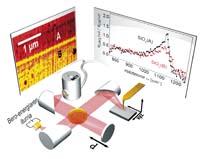CIC nanoGUNE develops an infrared spectroscopy system for nanometric samples

A group of researchers from CIC nanoGUNE and Nefere GmbH (Germany) have developed an infrared spectrometer with a resolution of this type of infrared spectroscopy systems: nano-FTIR. In the future, this technique could be used to study the local chemical composition and structure of polymeric composites, semiconductor devices, minerals or biological tissues. The work has been published in the journal Nature Materials.
The absorption of infrared light is characteristic of the chemical composition and structure of the materials. For this reason, in the infrared spectrum can be seen as the "fingerprint" of a material. Thus, infrared spectroscopy has become an important tool for the characterization and identification of materials. However, it is impossible to obtain a map of infrared spectroscopy with conventional optical instruments in a single nanoparticles or molecules or in modern semiconductor devices, that is, on a nanometric scale.
The spectrometer developed by researchers of CIC nanoGUNE and Nefere uses a pointed metal tip to scan the sample surface. For this purpose, the tip receives infrared light from a heat energy source. The tip transforms the light that reaches the end into an infrared point of the nanometric scale (i.e., nanofoca). Analyzing the dispersed infrared light with a spectrometer specially designed for it, the researchers have been able to record the infrared spectrum of the ultra volume samples under a resolution of more than 100 nm.





